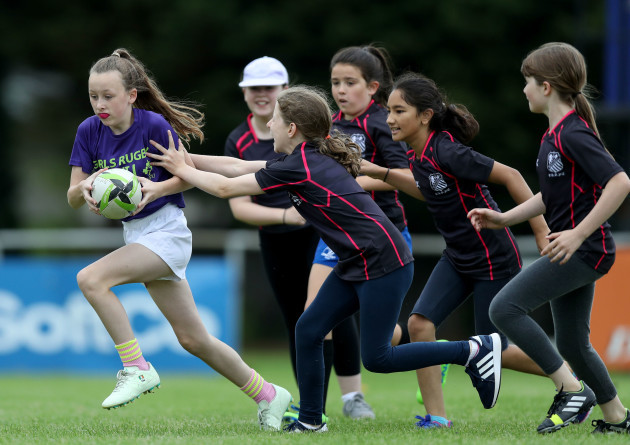THE WOMEN’S INTER-provincial championship and U18 Series both kick off this weekend, meaning the best female rugby players in Ireland will be battling it out over the next three weekends.
Further down the pathway, it has been a huge summer for girls rugby in this country, with more than 1,000 youngsters taking part in the IRFU’s ’Give It A Try’ campaign.
The majority of those girls had never played rugby before and the hope is that the eight-week programme they’ve been part of in recent months will eventually lead to some of them being the inter-provincial and international stars of the future.
Nora Stapleton, the former Ireland out-half who is the women’s and girls rugby development manager for the IRFU, has been driving the programme since its “pilot project” phase last year.
After 13 clubs were involved in the summer of 2017, there was an explosion in interest this year.
“I estimated that we might get 500 kids this year and 20 clubs was the aim,” says Stapleton.
“We got to 38 clubs around the country and we had 1,050 girls playing rugby. It’s been a big success.”
The programme was aimed at girls from the age of 10 to 14, with the IRFU providing a workshop for coaches and club coordinators back in May before the programme began in June.
Starting with something as basic as running forward and passing backwards, the eight-week programme took players through handling and catching, evasion skills, support play and more, with the emphasis on “a fun, enjoyable environment.”
“The plan was that in week four, there would be tackling and by the time you got to week eight you could play a full-contact match, but because of the nice weather we had, the ground was like concrete and it meant we couldn’t do that,” explains Stapleton.
“We did some tackle practice and the kids all got introduced to that but we didn’t go to full-contact.
“We will probably keep it as touch for the matches next year too because it worked so well and I think at that time of year, it gives them that taster. We will still introduce them to tackling but when it comes to matches, we’ll stick with touch.
“The game is more of an offload touch, not the kind of touch people might be used to. When you get a touch, you can still offload the ball to your support player, so it’s encouraging that support play, which is far more like general rugby.”
Around 60% of girls who took part this summer hadn’t been members of a rugby club before, and Stapleton stresses that it was key for the IRFU to bring more of this age grade into the sport, linking the ever-growing girls minis rugby on towards the U14, U16 and U18 grades and into adult women’s rugby.
“It’s about joining up all the age brackets. This is important because either side of it, we’d been seeing the growth already.”
Stapleton has been enthused by the growth of girls rugby in new places, citing the example of Kinsale.
The annual sevens festival in the Cork town is a big deal, of course, but this was Kinsale RFC’s first year catering for girls and they had over 40 players at training many weeks.
“They’re so delighted with it and now they’re trying to figure out what to do coming into the new season,” says Stapleton.
Indeed, that’s the next challenge for the clubs, provinces and IRFU – ensuring a high percentage of these new players stay in the game.
“Some of the girls will go into regular leagues and cups, but for some of the girls it will be about regular participation opportunities in their region – that could be once a month where clubs come together and play a couple of matches.”
In her role with the union, Stapleton has also been busy working on the new action plan for women’s rugby in Ireland, with the IRFU set to release the much-anticipated strategy in September.
“How do we get more girls playing, how do we give them more opportunities to play?” says Stapleton of what she’s been working on. “A lot of people have said they’d like to play more but they don’t get the chance to, so that’s something we want to fix.”
The plan for ‘Give It a Try’ next summer is to have a similar number of clubs involved and to ensure that players attend as many of the eight training sessions as possible, rather than dipping in and out across the two months.
But two years in, Stapleton is pleased with what the programme has achieved and how it has opened people’s eyes.
“For some of the clubs who were doing this for the first time, they’ve often been shocked at the ability of the girls, how they’re able to adapt and get stuck in,” says Stapleton.
“With some of the tries they’ve scored or their evasion skills, it’s really nice to see how excited the coaches on the sideline are getting. We’ve heard them saying, ‘God, I didn’t know girls of this age could do that.’
“That’s what it’s all about and there’s so much talent out there. 10 to 14 is the age where lots of girls stop playing sport, so if we can keep them active through rugby, that’s a huge achievement.”
The42 is on Instagram! Tap the button below on your phone to follow us!




